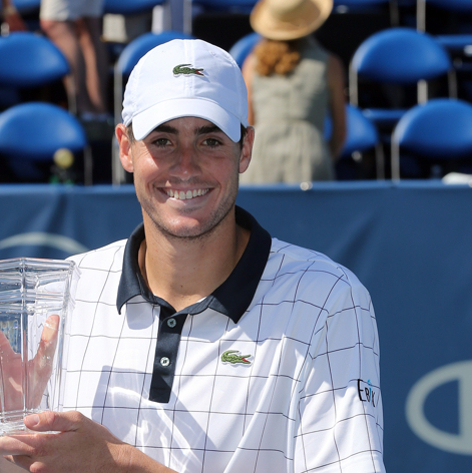 What a difference a few months make.
What a difference a few months make.
For some reason, Europe seems to get John Isner in a funk. He’s played well in Europe before, but the last two years, not so much. The solution, it seems, was return to home soil. Last year, Isner decided to play Newport. Newport is played the week after Wimbledon and usually has among the weakest draw in all of men’s tennis.
Those who play well on grass typically skip it because Wimbledon is the culmination of grass tennis, so why bother? Those who prefer clay stay in Europe where there are still a few clay events to be had.
Indeed, due to the weak draw, people had begun talking about the Newport curse. The number 1 seed had never won the title. Isner changed that last year, as he won it. And, he won it this year as well as the top seed.
When New Haven, traditionally the last US Open Series event before the US Open, was dropped and Winston-Salem replaced it, John Isner had a huge incentive to play. Having been raised in Greensboro, Winston-Salem was a stone’s throw away.
Winston-Salem also tends to get weak draws, though not as weak as Newport, but this year, it was particularly strong. Specifically, Tomas Berdych and Jo-Wilfried Tsonga both entered the event. It can be tough to bring in top ten talent the week before a Slam, but Berdych had not played well since Halle, having lost early in a series of events. He needed confidence heading into the US Open. Tsonga, by contrast, injured himself by running into a hydrant, and had to withdraw from Cincy, so he, too, wanted some matches.
Both did well, but John Isner showed that he’s one of the best competitors on tour. This is probably the biggest difference between Isner and Querrey, though Querrey is getting his game back in gear after spending months trying to improve his game. Isner has the bigger serve, but Querrey moves better. Still, when it comes to crunch time, Isner seems to win more than Querrey does.
In the final, Berdych was probably marginally favored. He has a bigger forehand and moves better than Isner. On the other hand, a streak of losing early in tournaments showed the erratic nature of Berdych’s game. As a big man, Berdych still lacks the movement of shorter players. He relies on a flatter stroke than most, and plays fairly high risk. When his game isn’t clicking, he is prone to upset.
But Berdych seemed the more solid of the two in this match. Isner had no chances in the Berdych serve, and lost the first set, 63. However, as Isner often does, his serve bailed him out of situations long enough for him to get one game with break points. Isner took advantage of the situation and secured the second set, 64. From then on, both players held serve until the inevitable tiebreak. Isner has had an outstanding tiebreak record this year, and despite match points against him, managed to take the tiebreak, 97.
Isner has a pretty decent draw in the US Open. The top seed in his section is Janko Tipsarevic. There’s no one spectacularly tough in his section, and should he reach the quarterfinals, the top seed expected is David Ferrer who, while having a torrid summer between the French Open and Wimbledon, seems to have cooled down some.
The slight downside is how much Isner has played, as he played the Olympics and made a deep run in Toronto. He did skip Cincy, however, so that should help.



![[Stockholm] Dimitrov wins first ATP title with 3-set victory over Ferrer](https://www.essentialtennis.com/wp-content/uploads/2013/10/20131021grigor-500x383.jpg)
![[Metz/St. Petersburg] Simon and Gulbis are champions!](https://www.essentialtennis.com/wp-content/uploads/2013/09/20130922gulbis-500x383.jpg)

![[Cincinnati] Nadal wins 26th Masters 1000 title with win over Isner 7-6, 7-6](https://www.essentialtennis.com/wp-content/uploads/2013/08/20130818rafa-500x383.jpg)
![[Montreal] Nadal crushes Raonic to win 25th Masters 1000 title](https://www.essentialtennis.com/wp-content/uploads/2013/08/20130811nadal-500x383.jpg)